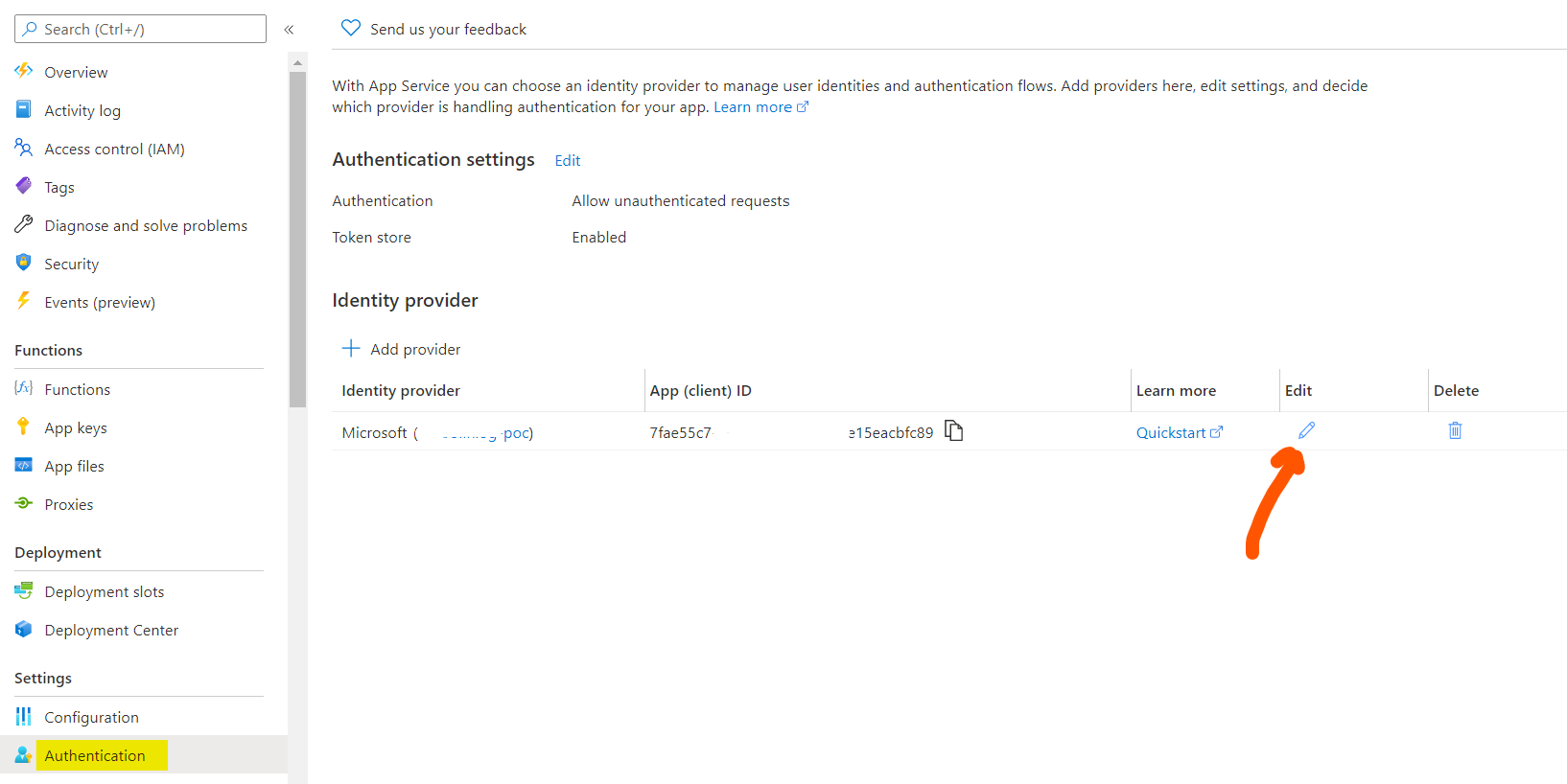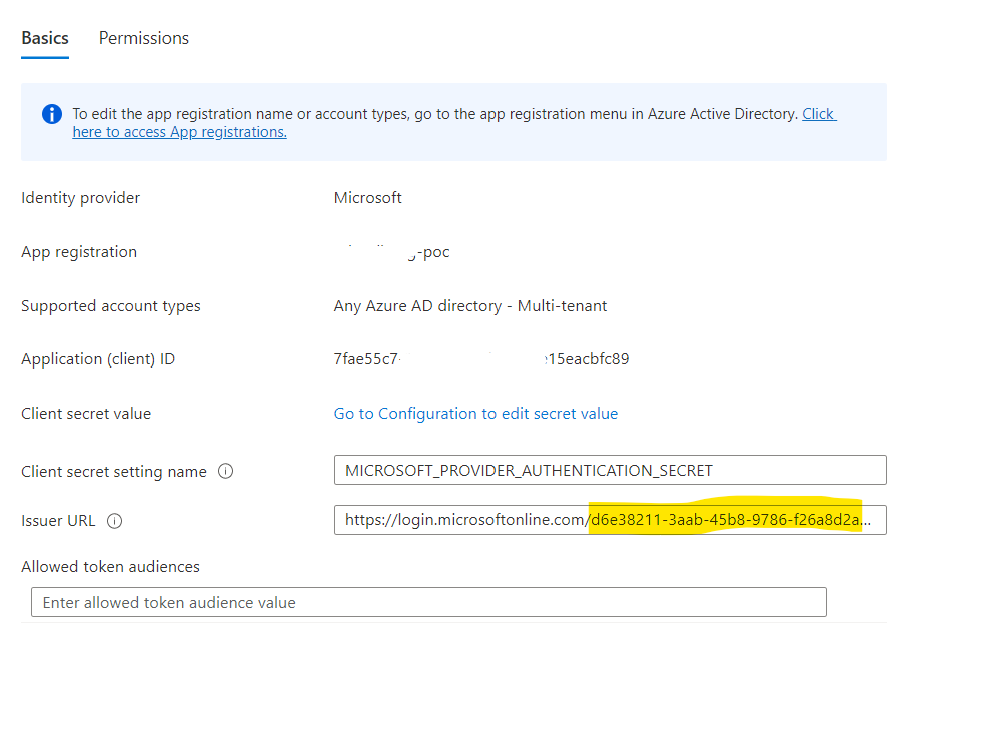Azure Functions with multi tenant authentication
Azure Functions (and Azure App Service) support authentication out of the box. They even made a wizard to get you started quickly. This is really useful if you just want users from your tenant (or a specific other tenant) to login.
Check-out the documentation to get started.
Allow multiple tenants
The wizard configures authentication for users from a single tenant, but you can change that really easy.
- Open your Functions app (or app service) in the Azure portal
- Click Authentication
- Click the pencil after the (pre) configured Microsoft provider.

Issuer url

The Issuer URL set by the wizard is in the format https://login.microsoftonline.com/<your-tenant-id>/v2.0.
This issuer URL does several things:
- Signal the authentication middleware to use the OpenID Connect configuration from
<issuer-url>/.well-known/openid-configuration. - Set the expected issuer in the identity token to the issuer url.
To allow users from multiple tenants, you would normally just use another endpoint. Just change the <tenant-id> to organizations was my first thought.
This does allow the middleware to download the correct OpenID configuration (and show a login screen with only organization accounts), but the issuer in the identity token contains the <tenant-id> and not organizations. This means your login request will be denied by the middleware.
Magic issuer URL
In this really long thread on twitter I finally got in contact with Connor from Microsoft. Who told me that to allow access from multiple tenants, you’ve to set the issuer URL to https://login.microsoftonline.com/common/v2.0
This url is also in the endpoints list (and allows any user with a personal or business account to login).
They build a special case when using this exact issuer url, in that it disables issuer validation. So to support multiple tenants (and personal accounts) just change the Issuer URL to https://login.microsoftonline.com/common/v2.0.
Filter tenants and personal accounts
The authentication middleware currently doesn’t support setting a list of allowed issuers. So if you only want users from some tenants to access your application, you’ll have to build something yourself.
If you’re using C# to develop your functions, you have access to the user info in every request.
// Disallow unauthenticated users (if you allow Unauthenticated requests in the config)
if (req.HttpContext.User.Identity.IsAuthenticated) {
return new UnauthorizedResult();
}
// get the issuer
string issuer = req.HttpContext.User.FindFirst("iss")?.Value;
// Get a list of allowed issuers from somewhere, I recommend putting this in a easy changeable configuration setting.
string[] issuers = new string[]{"https://login.microsoftonline.com/d6e38211-3aab-45b8-9786-f26a8d2a6b52/v2.0", "https://login.microsoftonline.com/f3c6fd84-ba70-4cef-8c8f-0fd131a23b8e/v2.0"};
if (!issuers.Contains(issuer)) {
return new UnauthorizedResult();
}
// Filter personal accounts
// The issuer for personal accounts is always the same, according to jwt.ms
if (issuer == "https://login.microsoftonline.com/9188040d-6c67-4c5b-b112-36a304b66dad/v2.0") {
}
Access graph api with user token
The authentication middleware can also manage access tokens for your application, that is if you turned on the Token Store.
Microsoft will forward an access token for the user that is valid for the Graph api in the X-MS-TOKEN-AAD-ACCESS-TOKEN header. It also disallows some malicious user to add this header to a request. So if you’re getting this header in your request, it is coming from Microsoft!
var token = req.Headers["X-MS-TOKEN-AAD-ACCESS-TOKEN"]?.ToString();
Easy Auth
The library handling the authentication is called “EasyAuth” internally. You can check out how it roughly works here.
I think you can just see it as a gate in front of your web application. And you can configure it to always require a key Require authentication or to check the ID if the user has one but still allow users who didn’t login Allow unauthenticated requests.
Possible improvements
While the wizard to configure authentication is quite good to get started, I would like to see some improvements:
- Support for the issuer
https://login.microsoftonline.com/organizations/v2.0. - If you pick
Any Azure AD directory - Multi-tenantin the wizard, it should automatically set the Issuer URL to this newly implemented special issuer. - If you pick
Any Azure AD directory & personal Microsoft accountsit should set the Issuer URL tohttps://login.microsoftonline.com/common/v2.0because that is what you’re asking for. - And lastly, it would be great if you can configure a list of allowed issuers in combination with either the
commonor theorganizationsissuer. That would make it a lot easier to support multi tenancy while still being able to control which tenants you allow to your application.
Multi tenant applications require partner ID
If you got this far, you probably implemented your multi tenant authentication. Since November 9th of 2020 Microsoft requires a partner ID to be set on the application registration for users from other tenants to be able to consent to your application.
You can do this in at the Azure AD portal. App registrations -> your app -> Branding. Where you off course need a Microsoft Partner ID. You can get one by registering your company for the Microsoft Action Pack ($400/year).